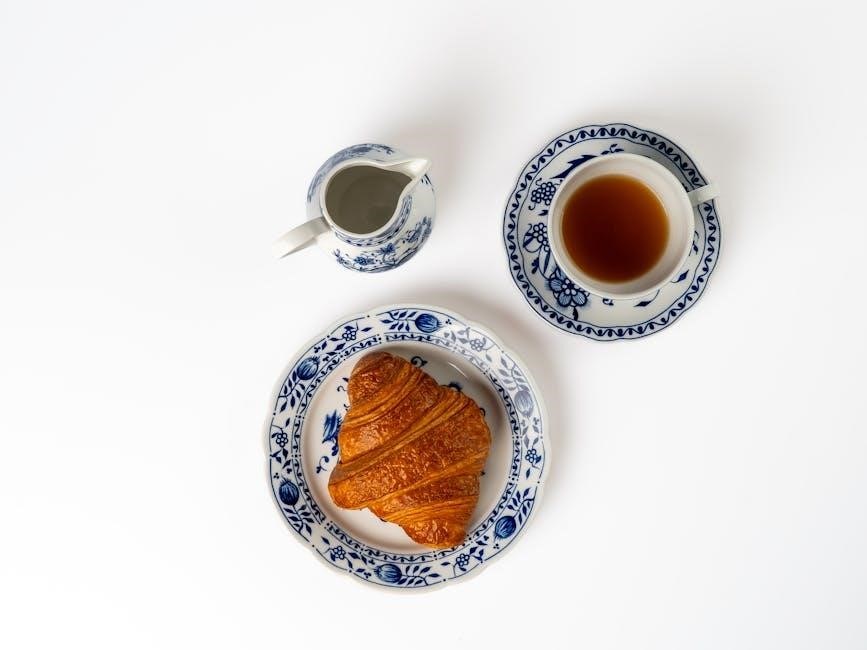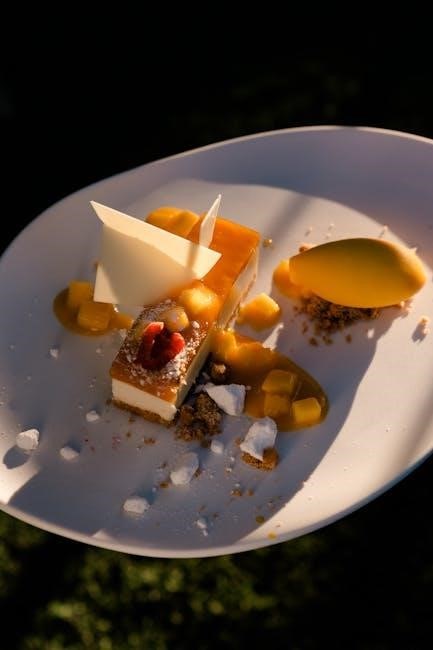A Light Guide Plate (LGP) is an essential component in LCDs, utilizing materials like PMMA to evenly distribute light, enhancing display uniformity and efficiency․
1․1 Definition and Basic Functionality
A Light Guide Plate (LGP) is a transparent panel, typically made of materials like PMMA or acrylic, designed to evenly distribute light across its surface․ Its primary function is to guide and diffuse light from a source, such as LEDs, ensuring uniform illumination in applications like LCD screens and edge-lit lighting systems․
The LGP achieves this by incorporating microstructures or patterns on its surface, which refract and scatter light rays, eliminating hotspots and glare․ This ensures a smooth, consistent light output, making it indispensable in modern display and lighting technologies․
1․2 Historical Development and Evolution
The Light Guide Plate (LGP) has evolved significantly since its inception, aligning with advancements in display and lighting technologies․ Early LGPs were simple in design, relying on basic light-diffusing patterns․ With the rise of LCDs in the late 20th century, LGPs became integral to backlighting systems, improving display uniformity․ The 2000s saw the adoption of edge-lit LED backlighting, driving demand for thinner, more efficient LGPs․ Innovations in materials like PMMA and advanced manufacturing techniques further enhanced optical performance․ Today, LGPs are optimized for high luminance, low power consumption, and design flexibility, catering to diverse applications from smartphones to large screens․ Their evolution reflects the broader shift toward energy-efficient, high-quality display solutions․
1․3 Key Design Principles
The design of Light Guide Plates (LGPs) focuses on achieving optimal light distribution and uniformity․ Key principles include the strategic placement of light-diffusing dots or patterns on the plate’s surface to control light dispersion․ The material selection, typically high-optical-grade PMMA, ensures minimal light absorption and high transparency․ Thickness and size are carefully calibrated to balance light transmission and structural integrity․ Additionally, the plate’s edge design and surface finish play critical roles in minimizing glare and reflections․ The integration of reflective layers or coatings further enhances light direction and efficiency․ These principles collectively ensure that LGPs deliver consistent, high-quality illumination across various applications, from displays to lighting systems;

Materials and Manufacturing Process
Light guide plates are typically made from PMMA or acrylic materials, known for their high transparency․ Manufacturing involves cutting, drilling, and laser etching to create precise light-guiding patterns, ensuring optimal light distribution and uniformity․
2․1 Common Materials Used (PMMA, Acrylic, etc․)
PMMA (Polymethyl Methacrylate) and acrylic are the most commonly used materials for Light Guide Plates (LGPs) due to their high optical clarity and ease of manufacturing․ PMMA, in particular, is favored for its excellent light transmission properties, making it ideal for applications requiring minimal light loss․ Acrylic, while similar to PMMA, offers slightly different mechanical properties and cost-effectiveness․ Both materials can be tailored to meet specific optical requirements, such as diffusion or refraction, by altering their molecular structure or adding optical-grade coatings․ Additionally, these materials are lightweight and durable, ensuring long-term performance in various lighting and display applications․
2․2 Manufacturing Techniques and Technologies
The manufacturing of Light Guide Plates (LGPs) involves advanced techniques to ensure precise optical performance․ Laser cutting and engraving are commonly used to create microstructures on the plate’s surface, enhancing light diffusion and uniformity․ Thermal forming and injection molding are employed for shaping, while nano-imprinting and hot stamping add functional patterns․ These processes ensure minimal light loss and optimal distribution․ Surface treatments, such as coating and polishing, further improve light transmission and durability․ Modern technologies integrate automation and precision engineering to maintain consistency and scalability in production, catering to various applications like edge-lit lighting and flexible designs․ These manufacturing advancements enable LGPs to meet the growing demand for high-efficiency lighting solutions․

Applications of Light Guide Plates
Light Guide Plates are widely used in LCDs, edge-lit lighting, and flexible designs, providing uniform illumination and enhancing display performance in various applications․

3․1 Use in Liquid Crystal Displays (LCDs)
Light Guide Plates (LGPs) are critical in LCDs for evenly distributing light across screens․ Made from materials like PMMA, they ensure high uniformity and luminance, enhancing display quality while maintaining efficiency․ LGPs are integral to backlight units, providing consistent illumination for crisp visuals․ Their design includes microstructures that refract and reflect light effectively, minimizing glare and hotspots․ This technology supports thinner, energy-efficient displays, making LGPs indispensable in modern LCD applications, from smartphones to televisions․ Their role in optimizing light distribution directly impacts the overall viewing experience, ensuring vibrant and clear images․ Thus, LGPs are vital for meeting market demands of high-performance, low-power displays․

3․2 Edge-Lit Lighting Solutions
Light Guide Plates (LGPs) play a pivotal role in edge-lit lighting solutions, enabling thin, energy-efficient designs․ By illuminating the edges, light is evenly distributed across the plate, ensuring uniform brightness․ LGPs are typically made from high-optical-grade materials like PMMA, which offer excellent light transmission and durability․ This technology is widely used in applications such as backlighting for displays, architectural lighting, and decorative illumination․ Edge-lit LGPs are particularly favored for their slim profiles and ability to produce homogeneous light without hotspots․ Customizable optical patterns can be embedded to enhance performance, making them versatile for various lighting needs․ Their efficiency and design flexibility have made edge-lit LGPs a cornerstone in modern lighting solutions, driving innovation across industries․
3․3 Flexible and Customizable LGPs
Flexible and customizable Light Guide Plates (LGPs) offer versatility for diverse applications․ These LGPs can be tailored to specific shapes, sizes, and optical patterns, making them ideal for unique lighting designs․ Flexible LGPs, such as fiber-optic-based solutions, allow bending without breaking, enabling use in curved or complex geometries․ Customizable options include varying dot patterns, thicknesses, and materials to suit different lighting needs․ This adaptability expands their use beyond traditional displays, into automotive, medical, and decorative lighting․ The ability to customize ensures optimal performance for specific applications, making flexible LGPs a key innovation in modern lighting technology․ Their durability and lightweight nature further enhance their appeal across industries․
Optical Properties and Performance
Light Guide Plates (LGPs) ensure even light distribution, high uniformity, and minimal glare, enhancing display brightness and color accuracy while maintaining optical efficiency and durability over time․
4․1 Light Distribution and Uniformity
Light Guide Plates (LGPs) are designed to ensure even light distribution across their surface, achieving high uniformity․ This is accomplished through precise patterns of light-scattering dots or microstructures embedded in the plate․ These patterns regulate the refraction and reflection of light, minimizing hotspots and glare․ Advanced manufacturing techniques, such as laser etching, enable intricate designs that optimize light diffusion․ Uniformity is critical for applications like LCDs, where consistent brightness and color accuracy are essential․ By controlling light spread, LGPs enhance display performance, ensuring a seamless viewing experience․ Proper light distribution also reduces energy waste, improving overall efficiency and prolonging the lifespan of the backlighting system․
4․2 Luminescence Efficiency and Durability
Light Guide Plates (LGPs) are engineered to maximize luminescence efficiency, ensuring minimal light loss during transmission․ Advanced materials like PMMA offer high optical clarity, maintaining brightness over time․ Durable designs resist degradation from heat and UV exposure, preserving performance․ LGPs are also resistant to yellowing and moisture, enhancing longevity․ Their robust construction withstands environmental stresses, ensuring consistent light output․ These plates are crucial for applications requiring high optical performance and reliability, delivering efficient and long-lasting illumination solutions across various industries․

Market Trends and Industry Insights
Growth in the LGP market is driven by demand for energy-efficient displays, with industry leaders expanding production and emerging innovations enhancing performance and sustainability․
5․1 Growth Drivers and Industry Leaders

The LGP market is experiencing significant growth, driven by increasing demand for energy-efficient displays and high-performance backlighting solutions․ Key industry leaders, such as Global Lighting Technologies (GLT), are expanding their production capabilities to meet rising demand․ These companies are investing heavily in advanced manufacturing technologies to improve efficiency and reduce costs․ Additionally, the adoption of LGPs in emerging applications, such as flexible displays and edge-lit lighting, is further fueling market expansion․ The use of high-quality materials, like Mitsubishi’s optical-grade PMMA, is also driving innovation and performance․ As a result, the LGP market is poised for continued growth, supported by technological advancements and strong industry leadership․

5․2 Emerging Innovations in LGP Technology
Emerging innovations in LGP technology are revolutionizing backlighting and display systems, with advancements in material science and manufacturing techniques leading the way․ Researchers are exploring nanostructured surfaces and laser-etched patterns to enhance light diffusion and minimize glare․ Flexible LGPs are gaining traction, enabling curved and bendable displays for next-generation devices․ Additionally, the integration of quantum dot technology with LGPs promises improved color accuracy and energy efficiency․ Innovations in sustainable materials, such as recycled acrylics, are also being developed to reduce environmental impact․ These advancements are driving the adoption of LGPs in diverse applications, from automotive displays to architectural lighting, ensuring continued growth and innovation in the industry․
Challenges and Solutions
Challenges like glare and uneven light distribution are addressed through advanced material coatings and nanostructured surfaces, enhancing durability and optical performance in LGP applications․
6․1 Overcoming the Issue of Glare and Reflection

Glare and reflection in LGPs are mitigated through advanced optical coatings and surface treatments․ Anti-reflective coatings reduce unwanted reflections, while micro-patterned designs scatter light evenly․ Additionally, edge-lit technology minimizes direct light exposure, reducing glare․ Nanostructured surfaces further enhance light diffusion, preventing hotspots․ These innovations ensure optimal light distribution and visual comfort, addressing challenges in various display applications; By integrating these solutions, LGPs achieve higher efficiency and improved user experience, making them suitable for diverse lighting and display systems․
6․2 Advances in Material Science for Improved Performance
Advancements in material science have significantly enhanced the performance of light guide plates․ High-quality PMMA and optical-grade acrylics now offer superior light transmission and durability․ Innovations like nanostructured surfaces improve light diffusion, reducing glare․ Additionally, the development of recyclable and lightweight materials addresses environmental concerns while maintaining optical quality; These advancements ensure LGPs meet the growing demand for energy-efficient, high-performance displays․ By leveraging cutting-edge materials, manufacturers achieve better luminance and longer lifespans, driving LGP technology forward in various applications․ This focus on material innovation ensures LGPs remain a critical component in modern display systems, delivering enhanced visual experiences across industries․
